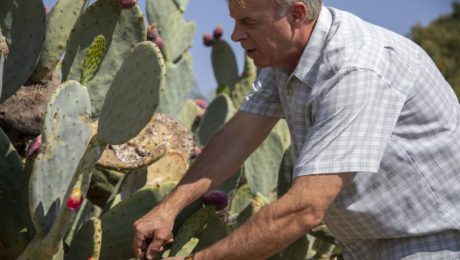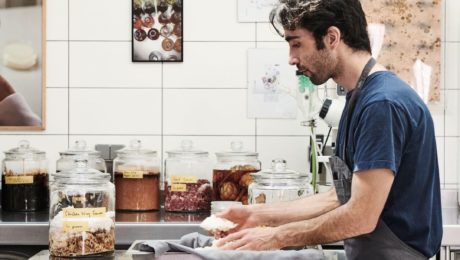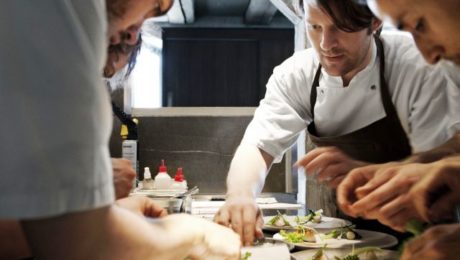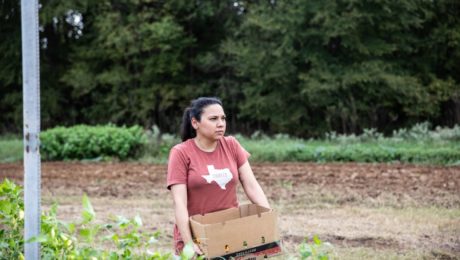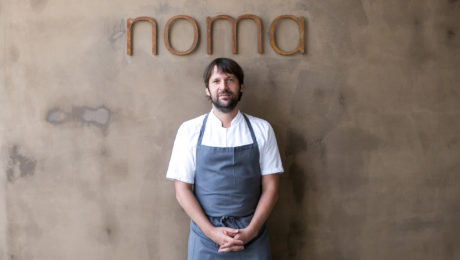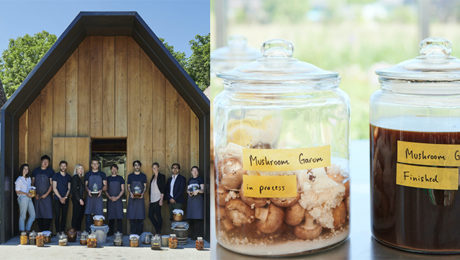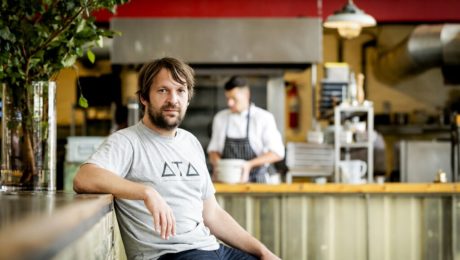Foraging for Cocktails
More restaurant owners are offering foraging tours for patrons, a farm-to-table experience where guests pick ingredients for their meal. The Los Angeles Times highlights Central Coast Distillery in Atascadero, Calif. They take visitors on a unique outing around San Luis Obispo County to learn about the “epicurean and medicinal qualities of botanicals.”
Distillery owner Eric Olson calls the tours “wildcrafting.” He shows guests how tequila is made, by roasting, mashing and fermenting local agave. He takes them through the hills of Paso Robles to pick prickly pears from nopal cactus, then collects bay laurel leaves, fennel, toyon berries and elderberry.
Guests are brought back to the distillery to create cocktails from their foraged goods. “I usually like to stick to the classics, but then put a personal little twist on them with something that we foraged,” Olson says.
Read more (Los Angeles Times)
- Published in Business, Food & Flavor
Chocolate Without the Cacao
Cacao is one of the most environmentally harmful and ethically dubious commodities produced on the planet. It plays a huge role in deforestation, uses an alarming amount of water and more than 2 million children work in cacao farms. Yet cacao hasn’t been reimagined the way other foods with similarly harmful footprints have.
“There’s a lot of ethical quandaries around the production of chocolate,” says Johnny Drain, PhD, co-founder of WNWN Food Labs. “Cacao is a huge contributor to climate change, and child labor and slave labor are hardwired into the supply chain.”
Drain’s nickname is the “Walter White of fermentation” because of his work helping pioneering restaurants and bars around the world incorporate fermentation into their food and drink. Now Drain can add “Willy Wonka of chocolate” to his resume. He is co-launching a cacao-free chocolate, next in the wave of alternative products designed to replicate flavor and texture without a harmful production cycle.
A Chocolate-Potato Connection?
WNWN (Waste Not, Want Not, pronounced “Win-Win”) happened by chance. About five years ago, Drain was boiling old, green potatoes, and leaned his head into the steam. He was surprised it smelled like chocolate.
“I had this light bulb moment where I thought ‘There must be some compounds within the skins that are also found in cacao and chocolate.’ I wondered — ‘Could I make chocolate from potatoes? What other weird and wonderful things could make chocolate?’” Drain says.
WNWN plans to release a small-run batch of their chocolate next month. Drain and co-founder Ahrum Pak, a former investment banker and fellow fermenter-turned-food-activist, are calling the product category choc.
WNWN’s choc ingredients are proprietary until its formal release but, as with traditional chocolate, they are plant-based and fermented. Drain describes them as familiar, whole ingredients that are common in an average person’s diet.
“It’s not a Frankenstein, lab-created product, mixing this potion with that potion. We take whole ingredients, we ferment them just as we would chocolate, then we end up with this delicious chocolatey paste that goes into a quite conventional chocolate-making procedure,” Drain adds.
WNWN also replaces cocoa butter — made from cacao pods — with plant-based oils. Cocoa butter is what gives traditional chocolate a silky, creamy texture as it melts in your mouth.
Fermented Flavors
At the heart of choc’s flavor, though, is fermentation.
“Cacao is fermented to make chocolate in the same way our product is fermented. We use similar, friendly microbes to create complexity,” he says. “We’re recreating that flavour profile of chocolate that we all know and love using the same fundamental techniques that are used to make chocolate.”
High-quality chocolate contains roughly 600 different flavor and aroma molecules. Cacao fermentation involves lactic acid and acetic acid bacteria, along with various yeasts, to create its flavor.
“If you didn’t have that cocktail of microbes, you would end up with something that only tastes vaguely like the chocolate we know and love,” he adds. “At the heart of this is fermentation. The product that we have, if we produced it without the fermentation processes, it wouldn’t taste anything like chocolate, just like if you eat a raw cocoa bean or even a roasted, unfermented cocoa bean, it doesn’t really taste like chocolate. You have to have that very complex cascade of chemical reactions, made possible by the fermentation, to get the final chocolate flavour.”
The Next Big Alt Movement?
Drain is quick to point out WNWN is not the only company trying to create what he and Pak have coined “alt-chocolate.” Three companies — QOA, Voyage Foods and Cali-Cultured — all officially launched in the past three months.
Some of these companies have been operating in stealth mode for a number of years but made official launches once word of competitors began to circulate. QOA and Voyage appear to be using approaches similar to that of WNWN. CaliCultured is using a syn-bio precision fermentation route to modify yeast cells to produce lab-grown cacao cells that are genetically identical to those found in the wild.
Drain says he’s encouraged by the other companies.
“It’s exciting that there’s multiple people working in this space,” he says. “Look at the plant milk space or alternative protein space — there’s definitely plenty of room in this marketplace too, and collectively we are all doing this because we care about the ethical and environmental damage being wrought by the current cacao supply chain.”
European and American consumers historically dominate chocolate sales, but chocolate sales all over the world are increasing.
Drain and Pak feel that a shake-up in the industry at the top is needed. Huge international producers are responsible for the vast majority of global chocolate. Mars, Nestle and Hershey promised over 20 years ago to stop using child laborers, but reports say the problem continues.Similarly, these companies pledged a decade ago to source more sustainable chocolate, but negative environmental problems from cacao continue to increase.
“The way in which we consume food has to change. It’s unrealistic that millions of tons of mass-produced cacao is somehow ethically- and sustainably-produced,” Pak says.
Drain adds; “So, really, we’re not anti-chocolate, we’re anti-big-chocolate produced in unethical, unsustainable ways.”
Recreating Food
Chocolate is merely the first challenge that WNWN wants to address. Coffee and vanilla are next, foods with similar human rights and sustainability concerns. The company is building a software system that can ideate fermentation pathways for creating sustainable, flavour-identical analogs to delicious – but unsustainable – products.
“When you really start looking at how most of the world’s food is produced and consumed, there are so so many cases where it’s produced in a really terrible and damaging way,” Drain says. But “the market wouldn’t have been ready for a product like this five years ago. People are becoming much more aware of where their food comes from. People are thinking about ‘How do I make my purchasing habits, my diet better for the planet in a way that I don’t have to sacrifice the flavors and taste that I love?’ There will be work to do. But people are more receptive now that fermentation is more of a household name than it was five years ago. I think the fact that more people want to remedy these challenges is brillant.”
Drain will be speaking FERMENTATION 2021 on “The Alt-Universe”
- Published in Business, Food & Flavor
Jason White:“It’s Cool to be a Fermenter”
While more chefs and cooking enthusiasts are experimenting with fermentation, they’re skipping the basics and jumping straight to complicated dishes. The foundational steps of cooking are fine-tuned only with time and patience, with hours spent mastering the simple recipes first, according to Jason White, director of the fermentation lab at Noma restaurant.
“It’s just as important for you to make a delicious pickle and a wonderfully balanced kombucha as it is for you to make an incredibly long-aged batch of miso,” White says. “We can never forget that, whenever we start approaching these biological processes and these fermentation processes, that we also take advantage of the beginning stages of learning each individual step along the way. I can’t tell you how important it is for a person who’s emerging into the art of fermentation to stop and pause for a minute and take the opportunity to connect dots. Each microbe that we’re using to ferment things has some kind of mechanism, and an ingredient that we’re going to ferment has a composition that benefits that microbe.”
White spoke at Harvard University’s Science & Cooking Lecture Series, on the topic Fermentation: A Springboard for Modern Gastronomy. He began his director role at Noma last year and has since helped the world-famous restaurant earn its third Michelin star in September.
In his lecture, White stressed observational skills — honed in the early years of learning to ferment — are one of the most important qualities for a fermenter. The best way to “really understand what an ingredient is and what it has to offer a microbe” is through the senses. When you cut into the ingredient, does it feel dry? Does it smell of essential oils? Does it taste overripe?
“Fermentation is one of those weird occurrences in nature where humans intentionally create something only to watch it decompose, and when it decomposes it produces something that’s more valuable to us,” White says. “I am not a chef, I am not a scientist, I am a dreamer and I am a fermenter and my life journey is going to be dedicated to the act of microbial processing.”
From Texas to Denmark, Fermenting with Local Agriculture
A native of Albuquerque, New Mexico, White began a career as a fermentation consultant for restaurants and distilleries in Texas. He worked for two years at Noma before returning to the U.S. in 2019 as head of the food research lab at Audrey restaurant in Nashville.
The early days of his career in gastronomy weren’t spent in beautiful, state-of-the-art kitchens like those at Noma. White’s first experiences as a professional fermenter were spent cooking in a small wooden shed in the Texas heat.
Environment is a critical element to fermenting. Texas is vastly different from the areas that are the globe’s cornerstones of fermentation — Japan, Korea and Taiwan — and which had inspired White. Texas, for example, doesn’t have a huge variety of mushrooms or produce — but it does have chilies and lots of grains.
“I found a lot of joy adapting traditional recipes into something that was based off Texas agriculture,” White says. Much of his fermentation in those days was driven by koji, which grows well on the grains common to Texas.
White learned a key lesson that he incorporates in his cooking: use the local ingredients and agricultural systems available in the area.
“Every single ingredient on earth, you’re going to find something that is valuable to a fermentation process,” White adds. “Even if we can’t consume it as humans, you can use the fermentation process to make it more delicious.”
Respecting the Past, Propelling the Future
Fermentation has been around since the beginning of humanity. When we ferment, White says, we’re recreating the environment and the processes traditionally used where the ferment was first discovered and practiced.
“And, as fermenters, we are also carrying the knowledge of these practices through the generations,” White says. “And where we are with fermentation, it’s kind of like emergent pop cultures. It’s cool to be a fermenter.”
White characterizes his fermentation style as “somewhere between a control freak and a naturalist.” Fermenters have a “huge sense of responsibility” to maintain food safety, carry on traditional processes and teach new fermenters. …We are protectors of knowledge, we are protectors of ingredients and we are protectors of history.”
Whether fermenting at home for personal use or in a production facility for consumers, “We are all still changing the way microbes are evolving and we’re all still participating in the ancient act and it is truly beautiful….if anyone in this room wants to ferment, you are literally the future of fermentation.”
During his presentation, White demonstrated how to ferment persimmons. In Texas, local farmers would bring persimmons to the restaurant where he worked. They were hard and unripe, not flavorful enough to eat raw, so White soaked them in amazake, a fermented rice beverage. During his lecture, White sliced bright orange persimmons for an amazake bath.
“The beauty in this whole entire thing isn’t how complex it is,” White says. “Fermentation doesn’t have to blow your mind, you don’t have to be like ‘Oh my god, it’s completely transformed, it’s something I don’t even recognize and it makes my palate explode with flavor.’ No. Fermentation could also be something that respects an ingredient and leaves it as is. But enhanced fermentation is something that can make something that is not as valuable as it should be more valuable again. You can turn something that would maybe go in the trash…into something very delicious.”
- Published in Food & Flavor
Noma Finally Earns 3rd Michelin Star
Fourteen years after earning two stars from the Michelin Guide, Noma was finally awarded the illustrious third star.
“After so many years of working together, to finally achieve something like this is extremely special,” says René Redzepi, chef and co-owner of the Copenhagen-based restaurant, during Michelin’s ceremony for Nordic countries earlier this month. Redzepi said the announcement left him surprised and flabbergasted. “I’m completely blown away, it’s a new feeling for me. This opportunity happens once in your lifetime.”
Long lauded as one of the top restaurants in the world, Noma has an innovative fermentation lab and test kitchen that creates wildly imaginative and ingenious dishes. Their summer menu featured an edible candle made with cardamom, saffron and a wick of silvered walnut; a salad made with reindeer penis; and a cold-pressed beetroot juice served in a flower pot adorned with a ladybug made from raspberry and black garlic .
The reactions from food industry professionals echoed the same sentiment — the third star was overdue.
James Spreadsbury, restaurant manager at Noma, said during the ceremony that the staff at the restaurant has been patient. “At some point, we kept on and didn’t expect anything would change. But we were still so proud of what we did and believed in what we did. After so many years of working together, to finally achieve something like this is extremely special.”
Redzepi was also honored by Michelin. The Chef Mentor award, given annually to a chef sharing their knowledge to help others, was presented to him by Peyman Sabet, the vice president of business development for Michelin.
“It’s really about innovation and making the path for a new generation of chefs,” Sabet said.
Redzepi said he was humbled to receive the award. He noted that, when Noma opened 18 years ago, “I was a terrible leader…when you are in the industry, you find yourself becoming a head chef and you don’t have the tools to actually figure out how are you doing to do this, how are you doing to lead and inspire a team.”
He said years ago he “promised himself this is not who I wanted to be.”
“One of the most enjoyable things I have in my professional career is to see someone that’s been a part of your own success, but when they leave they have their own success. That’s really really enjoyable.”
Noma is proud of their alumni and highlights them on their website. Reads the webpage: “Our chef René was himself a stagiaire [a cook who works briefly, for free, in another chef’s kitchen] around the world before opening Noma. It is a part of sharing ideas and knowledge that is quite special in our trade. We wouldn’t want to be without stagiaires and we believe that everyone that has been through Noma shares in part of our success.”
Former Noma chefs include: David Zilber (nowat bioscience company Chr. Hansen), Thomas Frebel (head chef at INUA in Tokyo), Dan Giusti (founder of chef training company Brigaid), Matt Orlando (head chef at Amass Restaurant in Copenhagen), Søren Ledet (owner and restaurant manager at Geranium in Copenhagen) andMads Refslund (head chef of ACME in New York City)
- Published in Business, Food & Flavor
Beyond Kombucha: Pu’erh, Jun and Dark Tea
Tea consumption globally is increasing. But consumers don’t want a cheap, poor quality tea bag. They’re buying premium teas — and increasingly, dark, fermented teas.
“What’s trending right now seems to be authentic tea, tea that has great flavor, more closely married to the terroir. People are beginning to understand that it’s just fine to have tea. You don’t have to have coloring in it, you don’t have to have a lot of bits and pieces of fruit and flowers, there’s a genuine benefit to just understanding the terroir and keeping it simple,” says Dan Bolton, the founder, editor and publisher of Tea Journey. Bolton and two tea experts discussed two lesser-known fermented tea varieties in the TFA webinar Beyond Kombucha: Pu’erh, Jun and Dark Tea. “Tea just isn’t as good as it could be, without fermentation.”
A new study on tea demonstrates how important fermentation is to tea quality, Bolton says. Researchers from the Anhui Agricultural University in China recently studied the effect of surface microbiomes on the quality of black tea. The results found microbial fermentation in non-sterilized control tea samples produced complex compounds and more flavorful teas than with sterilized tea leaves. The results were published in the Journal of Agricultural and Food Chemistry.
“It’s a remarkable finding because, certainly for the last century or so, there’s been a lot of discussion about whether fermentation plays a role in the production and processing of tea,” Bolton says. The study proves “black tea is actually a result of both fermentation and oxidation.”
Pu’erh Tea
Jeff Fuchs — author, Himalayan explorer and co-founder of Jalam Teas — shared details of pu’erh tea. Pu’erh is a tea style from a strain of camellia leaf cultivated and produced in the Yunnan province. Fuchs spent over a decade living in there and is the only Westerner to have traveled the Tea Horse Road through Sichuan, Yunnan and Tibet.
“Pu’erh is a tea that certainly I think it’s been deliberately mystified to some degree,” Fuchs says. “It’s interesting that you have this very simple, raw material green tea that is now arguably one of the great boutique commodities.”
Fuchs stresses consumers need to research tea sourcing. Where is the tea coming from? How was it stored? Who stored it? Older tea cakes are being sold for large amounts of money, but can have questionable provenance.
“Young teas I think are making a big assertion in the tea world right now because they represent a closer line to the terroir, a closer line to the origin point,” he says, adding dark teas are becoming more popular in North America. He sees more bartenders experimenting with dark teas, playing with flavor compounds. “I think dark teas will come into the sway more and they’ll remain.”
Jun Tea
Jun is another tea style making waves in the fermented beverage market. It is a type of kombucha, but the base is green tea and honey instead of black tea and sugar. Brendan McGill shared his experience making jun — he is a chef and James Beard nominee; he owns the Hitchcock Restaurant Group in Seattle and the newly-launched Junbug Kombucha.
“Jun is a very special style of kombucha,” McGill says. “It’s shrouded in mystery, where these cultures originated. What we do know is how they’ve been developed and manipulated in fairly recent history. One of the joys I’ve had with this is just being extremely creative because i found that while the fermentation isn’t necessarily a delicate process, it has allowed us to modify and use a lot of different inputs that it’s actually a pretty robust fermentation process.”
McGill began making kombucha over a decade ago, as a replacement for beer and wine. He liked jun for its similar flavor to alcohol, the additional bioactive compounds that create a more nutritious drink and it’s made with honey instead of added sugar.
Junbug Kombucha uses filtered water, organic green tea, wild honey and, of course, a SCOBY. In the secondary fermentation, fresh herbs, berries and even mushrooms are added. Junbug flavors include Chaga Root Beer, Chili Raspberry and Maui Mana.
- Published in Business, Food & Flavor
Q&A with Jessica Alonzo of Native Ferments TX & Petra and the Beast
Cheffing is a second career for Jessica Alonzo. Originally a hospital administrator in Dallas, she liked the stability and the benefits, but wasn’t happy. She longed for the days around the kitchen table with her mom, cooking for large family gatherings — “I have such fond memories of food.” Hospital pay got her through culinary school, and then she joined the acclaimed Dallas restaurant FT33 as a line cook. It was there that she got introduced to fermentation.
“With fermentation, the transformation of ingredients is just insane,” Alonzo says. “Fermentation is not new, it’s something that we’ve been doing for thousands of years. It’s a lost art and now it’s starting to make a resurgence.”
Fermentation and whole food utilization are Alonzo’s specialty. Whole food utilization, the cooking technique of using the entire animal or produce, marries perfectly with fermentation. Instead of discarding food scraps, skilled chefs are using the byproducts in brines, condiments and sauces.
“I preserve with a purpose,” says Alonzo, a Texas native. “I’ve worked with farmers long enough to understand what works with their produce throughout the year and what doesn’t. I’ve harvested with them, I’ve worked on their land. It plays a big role in fermentation to know how to properly preserve what farmers are harvesting.”
Alonzo is the sous chef at Dallas-based Petra and the Beast, a James Beard Award semifinalist known for its seasonal tasting menu. She stepped back to part-time status this year and launched her own business, Native Ferments TX, a larder shop that sells local ferments and offers virtual fermentation classes. Below are highlights from TFA’s interview with Alonzo.
The Fermentation Association: Tell me where the idea for Native Ferments came from.
Jessica Alonzo: Misti (Norris, chef/owner at Petra and the Beast) and my husband really pushed me to do it. They were like “You have the drive, you have the knowledge — why not share that talent with others?” People are always messaging me on Instagram asking me about different fermentation methods, and now I can teach them through classes. I love fermentation, I’m just fascinated with it, and it’s just continuous learning for me. You feel like you never really learn everything with fermentation, there’s so many different types of cuisines and techniques.
TFA: Why is it so important to you to support local farmers through fermentation?
JA: With both Native Ferments and Petra and the Beast, I get to work with farmers and support them, which is really what I love doing. Noma is helping make fermentation popular again, opening people’s eyes to the fact that fermentation has been happening forever. Fermentation is not new, there’s a tradition to respect. It was done back in the day because of necessity, people had to figure out how to save their harvest, and fermentation made it so they’d have the nutrients from their harvest throughout the rest of the year.
During the pandemic, restaurant sales for farmers dropped off drastically. At Petra, we had one of our farmers come to us with like a hundred pounds of mushrooms they couldn’t sell and they were going to go bad. I preserved them and made mushroom conservas and dried and did all these things with it, and then we ended up selling some of the mushroom pickles and conservas. I don’t know if any other restaurant did that in Dallas. It forced us to be really creative with food.
On my website for Native Ferments, I have profiles of the main farmers I use. When I sell at farmers markets, I have a big board with their Instagram handles. It’s their livelihood, I don’t want any of their produce to go to waste or to compost, I want the community to enjoy it. The magic of fermentation is transforming these simple ingredients with the natural microbes around you. I’ve worked with many of these farmers long enough to know what type of technique works well to pickle or ferment. I want to help educate people and get them excited and spread the word about the farmers’ hard work.
TFA: Tell me more about whole food utilization.
JA: At Petra, Misti was more the meat charcuterie person. She knows how to utilize every part of a pig or an animal. My mind goes more to vegetables, which I think is why we make such a good team. It makes sense that whole food utilization and fermentation go hand-in-hand. It’s part of preserving. We may be prepping something for tasting and then we have like carrot scraps or like some sort of vegetable or fruit scraps and we’ll automatically turn that into a vinegar. Or we dehydrate our char and dehydrate skins and turn that into part of a seasoning for another dish. Or I’ve done like roots from spring onions, I’ll brine those or I’ve chopped them up and parts in a condiment. We try to be as low waste of a kitchen as possible.
I do that with my ferments here with Native Ferments, too. In my fennel kimchi, I use the entire part of the fennel in that fennel kimchi, the fronds, the stems, everything, and then if my ratios were a little different so I did have some fronds left over, I dehydrate those and make that into a powder and now i’m utilizing that powder into a cure that I’m using on carrots for vegetable charcuterie. Understanding flavor profiles, too, helps when you’re cross utilizing your larder.
TFA: So tell me what have been some of your favorite fermentation creations you’ve been working on lately.
JA: Vegetable charcuterie is pretty cool, I’ve gotten some local produce in different root vegetables and I’m working on different charcuteries with more whole utilization in the curing. So like using the fennel from powder for part of the cure with carrots. I’m doing some shiro shoyu for another chef here in town and gluten-free shoyu for myself. I just smoked some beets and I’m pickling them in a shio koji that I made with a half sour brine and some spring onions. I’m hoping it takes on a meaty, smoky-like brisket, I was really craving barbecue when I did it.
TFA: Why do you think fermentation has become such a bigger interest among chefs?
JA: I think chefs are understanding the importance of the different complexity that you get when you build with fermented food in your cuisine. When Misti and I create dishes at Petra, we always in every dish that we create have some sort of pickle or ferment. Whether it’s an actual fermented vegetable or it could be an amino sauce that I’ve made or a shoyu or using shio koji or something, you don’t get that same transformation just by sauteing vegetables. You see the transformation by marianating them in shio koji first or using a brine in your pasta sauce rather than using a lemon juice. That’s how you build on these complex flavors. Some chefs are really trying to understand that. Utilizing fermented foods in their cuisine, being more creative with their flavor profiles, that’s what we do.
TFA: What do you think is the future of fermentation?
JA: With the resurgence of fermentation, I think it’s going to be more accepted in every household. I would hope that it would be something that every household would have. My parents grew up in the ‘60s, when everything was in a can. We had our traditional Mexican food, but we also had those times where it was Americanized, like everything in a canned food. Fermentation, this really should be the norm. Consumers need to be more aware of how beneficial it is
- Published in Food & Flavor
Redzepi: We Need Restaurants to “Feel Alive”
Restaurants have been under tremendous economic pressure, suffering from business losses during the Covid-19 pandemic. And there’s now a staffing shortage, as long hours and low pay have driven many away from the industry.
Bloomberg columnist Bobby Ghosh explored how restaurant dining may change in an Instagram live interview with Rene Redzepi, owner and co-owner of Noma, Copenhagen’s two-Michelin star restaurant world-renowned for its experimental fermentation lab. Pandemic restrictions shut down Noma twice, forcing Redzepi to create additional revenue streams outside the traditional dining room.
In the summer of 2020, Noma opened an outdoor, walk-in burger and wine bar. Earlier this month, they announced Noma Projects, a direct-to-consumer line that will initially sell garums.
Below are highlights from Ghosh’s interview with Redzepi.
Ghosh: What did you learn about how people were feeling about returning to restaurants?
Redzepi: Restaurants, you don’t need them to stay alive but you need them to feel alive. That was very, very clear, that people were ready to go out. You know they say it’s the catch-up effect, and that definitely happened here in Copenhagen. People were everywhere, they were in piles to get a bite to sit down, have a glass of wine and meet other people.
Ghosh: When you began to think about reopening the proper dining space and planning your menu for the reopening, did you have any particular thoughts or concerns about whether people’s habits in restaurant dining might have changed in the course of the year that they were all locked up?
Redzepi: Yeah, so we went through the first lockdown, opened up, we were open for about five months and then it all came back and we had to close (again during the second lockdown). On the second lockdown, we were shut for six months and, in that time, we were very worried about everything, I mean we still are, but I guess we’re a little less worried now than before because we’re finally open again. We did think “Would people even sit for hours in a restaurant? What is it that everyone wants?” Besides that, people in Denmark, they started really cooking at home again. Takeaway offerings had become quite common, even from some of the best restaurants, something that would be considered completely impossible five years ago. If you had takeaway as a fine dining establishment, you sort of sold out in a way and that was starting to happen.
But I decided with myself, and that was a personal decision, is that in my life I need this creativity, I need to have guests, I need to work on a menu on a daily basis, so during the lockdown I went to work every day in the kitchen as if we were going to open the following day. We actually made two full menus and one of them will never be served because we ended up being closed throughout it. And then we said “OK, let’s just open up and see what happens, will people still want to come out?” and we opened up our reservations knowing that we would cater only to 100% local crowd and it’s gone really well, really really well.
Ghosh: The thrill of being in a nice restaurant and being able to talk to people and enjoy a meal is incomparable um and I do appreciate the value of fun after the year and a half that we’ve all had. Can you give us an example of a dish that you have in your menu now that reflects this attitude of fun, the surprise.
Redzepi: Swedish saffron believe it or not, it’s really, really strong and tastes amazing. We make this fudge with it and we found out that you can actually use the sort of the cutting of walnut as a wig for candles because the oil content in the walnut makes it flammable. And so we basically shaped or molded this little toffee into a candle. It sounds complicated but it’s quite easy to do when it’s hot and then we put this walnut light into it and it comes to the table when they’re drinking coffee and people think it’s you know for coziness and then as it burns out people are then instructed to eat it that’s a that’s a moment where that’s fun you know it’s creativity, it’s delicious it surprises people and it just really makes it makes a difference to people you can feel that they’ve been needing something like that.
Ghosh: What have you learned that you didn’t already know about restaurant economics over the past year that now factors in your thinking about what Noma is and what Noma needs to be in the future.
Redzepi: Oh man, you’re hitting something that we’ve been talking about for the past two years because, particularly in the last year-and-a-half, restaurant economics, they’re terrible. We’ve had 18 years of operation and we’ve had an average profit of 3%. It’s just enough to keep us running and keep painting the house, so during this pandemic we did think to ourselves “Are we going to continue like this for another 18 years, where we don’t have any money to change anything, even if we want it?” You know we’re going to have to find different ways of operating so that we can have a different economics in it. We have to figure out a way if we want to be here for another 18 years because you know it won’t continue like this. So we have definitely thought of many many things and recently we launched this thing that we call Noma Projects. Noma Projects is a sort of a platform to launch a myriad of things, it’s a for-profit company, but we only want to attack projects that also connect to some sort of a worldly issue, and the first project one is is a vegan and a vegetarian garum sauce that you use as a flavoring to add umami to your vegetarian and vegan cooking. It’s a way to help people eat more vegetarian so that’s project one, that’s something that we worked on almost almost since the first lockdown that happened to us we were like we need to step into this.
Ghosh: About six months ago, I did a piece about restaurant economics and the pandemic. I talked to your friend David Chang of Momofuku. We’re saying that we have to figure out more ways to find revenues outside of the dining room. You know, can we get 50% of the revenue from outside of the dining room where the margins are larger to sustain, to underwrite the amazing creativity that goes on in your kitchens? Is that possible? Have consumer tastes or consumer behaviors now changed in a way that will allow that kind of thing?
Redzepi: I think what happened during the pandemic is that it’s been considered more OK for restaurants of say Momofuku caliber or Noma to actually think of ways to put better economics into the system. That has opened a new door and for us, we’re grabbing that opportunity, we need to, definitely. Our industry needs to, in general. It’s an industry that’s under copious amounts of pressure, we deal with poor profit margins, low incomes, people are overworked, they’re underpaid, there’s bad management and a lot of it is a result of there’s simply no money in the industry, people can’t afford to do maneuver any new way they want, and we don’t have any business training either. It’s very interesting what’s going on. I think a lot of creativity is going to come out of restaurants in the next couple of years.
Ghosh: Now in addition to being a chef, you’re a thinker in your line of work. Through MAD Academy, which used to be anyway your annual gathering of of great chefs from around the world, you’ve spent a lot of time thinking about your industry and the future of your industry. I imagine that during the course of the past year, year-and-a-half you’ve had many conversations with the kinds of people who would previously have come to that conference. What are some of the common themes, the common challenges for fine dining establishments?
Redzepi: I think in food in general, the most common problem, and I think it’s going to continue for a while, is that there’s a gigantic staff shortage right now. I think in the pandemic, a lot of people have had an opportunity to rethink their life and say “OK, am I in this industry for the next 20 years or is this a moment for me now to start studying or become a farmer or something else.” That is really the biggest issue that we have right now, there’s no question in my mind. This is something that at MAD we’ve been discussing for almost a decade. If we’re not able to help transform (and this includes myself by the way I’ve spoken about this many times) this gigantic lack of leadership that we face as an industry where we have a poor ability to actually just manage ourselves, manage our restaurants and be supportive of people, that will be the first step that needs to happen which is slowly happening. But then providing better pay and better work hours, that are related to economics. I see our industry being far from that, unless we figure out a way to either charge more that there’s more value towards foods and people that work in the industry or we find other revenue streams. Those are the big, big questions that we are dealing with at MAD. At Noma, I deal with this as a employer myself, how to actually be an inspiration, but how to also provide for staff that are having children, and how can we have everyone stay here for 40 years in this industry? That’s really hard questions.
- Published in Business
Noma Goes DTC
Noma is coming into the home kitchen.
The fermentation-focused restaurant, lauded as one of the top restaurants in the world, is selling its first line of packaged products. Two garums — vegan Smoked Mushroom and vegetarian Sweet Rice and Egg — will soon be available to ship internationally through the brand’s website, Noma Projects.
“It’s a space for us to channel our knowledge, our craft and experimentation into a new endeavor,” says René Redzepi, chef and co-owner of the Copenhagen-based restaurant.
Redzepi shared details of the launch in a video on the site. Noma Projects will include pantry products and community-based initiatives, “a way for us to address issues we care about through the lens of food.”
Noma’s Pantry Staples
The garums are Noma’s “take on a 1,000-year-old recipe that we’ve been developing over the past two decades.” Redzepi says the “potent, umami-based sauces” have been the “key to our success at Noma in our vegetarian and vegan menus.
He hopes the garums will help more people cook plant-based meals, announcing in the video: “We want to help you bring more vegetables into your everyday cooking.” The garums provide the flavor of meat and fish without the animal. The website description notes: “Shifting towards a more plant-based diet is the easiest way for an individual to help the environment. We hope these garums will do the same for you that they’ve done for us, help inspire and create more delicious plant-based meals when you cook at home.”
These products were developed in Noma’s Fermentation Lab, where dozens of pantry staples were tested before landing on the garums. A garum is the “concentrated essence of its main ingredient” with a strong umami flavor, and Redzepi describes it to the WSJ. Magazine (the luxury magazine published by Wall Street Journal): “It has the potency of a soy sauce, except it tastes of what it is.” Both are brewed with koji rice, what Redzepi calls the “mother fungus.”
The garums are currently fermenting and will be ready for shipping in the fall or winter. The expected price point is $20-$35 for a bottle.
And more garums are in the works. Noma Fermentation Lab director, Jason Ignacio White, says a roasted chicken wing garum is next.
“It tastes like super chicken stock with umami,” White tells WSJ. Magazine, ”so it’s a familiar flavor, but there’s something about it that you can’t really put your finger on, that makes your tongue dance.”
Improving Profitability
Despite Noma’s expensive tabs — the 20-course tasting menu costs 2,800 Danish kroner (or around $447), and the wine pairing is another 1,800 Danish kroner (or around $287) — in the 18 years since it opened, the restaurant has hovered at only a 3% profit margin. Redzepi hopes Noma Projects will make more money. While it is “a family-run garage project,” its goal is to reach a million customers.
Like many restaurants around the world, Noma shut down during the pandemic. They reopened as a burger and wine bar in June 2020, and the walk-up, outdoor dining experience was such a success that it became a permanent restaurant, POPL.
Noma resumed regular operations on June 1, 2021. The pandemic closure allowed Redzepi and his team to finally tackle the retail brand, something he said they had debated for years.
- Published in Business, Food & Flavor
“Magic Happens”
René Redzepi graced the pages of The New York Times again, but this time in the Arts section. The chef and owner at the world-famous restaurant Noma shared impressions on different musical pieces and other musings with writer Corinna da Fonseca-Wollheim. One of his favorites: Mort Garson’s “Plantasia” (an electronic album meant for plants) that he plays in Noma’s greenhouse.
Redzepi also touched on fermentation. “It’s an antidote to the world where everything is so fast; on-demand; lightning speed. To actually have things that you have to wait for and then something magic happens, I love that. The happiest people I know are people who are in nature all the time: foragers, bakers, fermentation experts. Sometimes I envy that focus. My job is to be at the center of everything that is going on.”
Read more (The New York Times)
- Published in Food & Flavor
Fish Sauce Without the Fish
Vegan chefs are creating animal-free fish sauce, using ingredients like seaweed, mushrooms, pineapple, soybeans, black beans and tofu for “the obvious oomph of umami.” A recent piece on Vice.com reported that many of these chefs were reluctant to use anything other than traditional fish-based ingredients. But they’ve found that these new fish sauces are especially popular with younger customers, many of whom are vegan or reducing the amount of meat-based products in their diets.
“Across the animal-free spectrum, home cooks and chefs have gotten creative as they deconstruct and recreate the magic of fermented fish,” continues the article.
Raj Abat, chef at New York’s plant-based Filipino restaurant Saramsan, was initially skeptical that a vegan fish sauce could work, but he found that fermentation was the transformative element. He said: “My first thought was: It has to look dark and black, and it has to smell really, really bad. Fermentation does that. It makes everything smell really funky, but when you taste it, it’s so delicious.”
Read more (Vice)
- Published in Food & Flavor

